Were floods and drought regular occurrences in ancient India?
Of course a big Yes! But ancient Indians implemented effective solutions to tackle these. Every region exploited its own traditional water harvesting techniques, harvesting every drop of rain water. Rainwater harvesting has been practiced since time immemorial, which also finds mention in our ancient scriptures. Hindu religious texts mention about Narad Muni visiting different kingdoms on earth and enquiring about the state of water bodies and whether the water was enough for the residents as well as animal population.
Our water situation is little complex but we can’t have scarcity given the necessary actions on replenishing our water. We have enough water for our need. If there is looming water scarcity, it is because mismanagement of life saving resource. We need to focus on “conserve at a place of consumption” rather than “transport from central point for consumption”
Ancient India had incredible science, for example ‘flying saucers’ in Rajasthan are clever water harvesting structure with an artificial catchment. Whatever rain fell was harvested and stored in an underground well. The simple common sense made them water secure. One hectare of land was saving millions of litres of water at every rainfall. Even in place like Jaisalmer; which had dried conditions of the world. The city itself has flourished despite receiving just 50 mm of rain in a year. Thanks to harvesting every drop…
Each state in India had grown it’s unique system of water harvesting, based on capture, conserve and consume rain at community level. Gujarat had Step wells, Rajasthan had Tankas, Ladakh had Zings, the Himalayan region had Guls, Bihar had it’sAharpanye, Mehghalaya had bamboo drip irrigation, Kerala had water harvesting structures actually built into the Ghats while TamilNadu has cascade tanks. Every region valued its rain endowment.
This system had unique element of local rainwater harvesting, scientific diversity and community based water management.
How rain water harvesting was used in ancient times.
Rainwater used to be collected from roofs as well as surfaces and in many places the water collected is redirected to a deep pit (well, shaft, or borehole), a reservoir with percolation, or collected from dew or fog with nets or other tools.
Water has been harvested in India since antiquity, with our ancestors perfecting the art of water management. Many water harvesting structures and water conveyance systems specific to the eco-regions and culture has been developed.
- They harvested the rain drop directly. From rooftops, they collected water and stored it in tanks built in their courtyards. From open community lands, they collected the rain and stored it in artificial wells.
- They harvested monsoon runoff by capturing water from swollen streams during the monsoon season and stored it various forms of water bodies.
- They harvested water from flooded rivers.
Paar system:
Paar is a common water harvesting practice in the western Rajasthan region. It is a common place where the rainwater flows from the agar (catchment) and in the process percolates into the sandy soil. In order to access the rajanipani (percolated water) kuis or beris are dug in the agor (storage area). Kuis or beris are normally 5 metres (m) to 12 m deep. The structure was constructed through traditional masonry technology. Normally six to ten of them are constructed in a paar. However depending on the size of the paar the numbers of kuis or beris are decided. Bhatti mentions that there are paars in Jaisalmer district where there are more than 20 kuis are in operation. This is the most predominant form of rainwater harvesting in the region. Rainwater harvested through PAAR technique is known as Patalipaani.
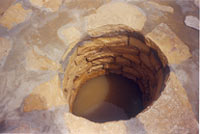
Talab / Bandhis:
Talabs are open reservoirs. They may be natural, such as the ponds (pokhariyan) at Tikamgarh in the Bundelkhand region. They can be human-made, such the lakes in Udaipur. A reservoir area of less than five bighas is called a talai; a medium sized lake is called a bandhi or talab; bigger lakes are called sagar or samand. The pokhariyan serve irrigation and drinking purposes. When the water in these reserviors dries up just a few days after the monsoon, the pond beds are cultivated with rice
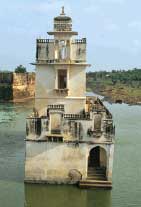
SazaKuva:
An open well with multiple owners (saza = partner), sazakuva is the most important source of irrigation in the Aravalli hills in Mewar, eastern Rajasthan. The soil dug out to make the well pit is used to construct a huge circular foundation or an elevated platform sloping away from the well. The first is built to accommodate the rehat, a traditional water lifting device; the sloping platform is for the chada, in which buffaloes are used to lift water. Sazakuva construction is generally taken up by a group of farmers with adjacent landholdings; a harva, a man with special skills in groundwater detection, helps fix the site.
 Johad:
Johad:
Johads are small earthen check dams that capture and conserve rainwater, improving percolation and groundwater recharge. Starting 1984, the last sixteen years have seen the revival of some 3000 johads spread across more than 650 villages in Alwar district, Rajasthan. This has resulted in a general rise of the groundwater level by almost 6 metres and a 33 percent increase in the forest cover in the area. Five rivers that used to go dry immediately following the monsoon have now become perennial, such as the River Arvari, has come alive.
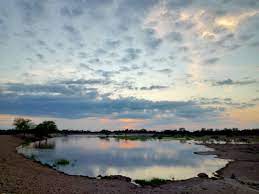
Pat:
Bhitadavillage ,Jhabua district of Madhya pradesh developed the unique pat system. This system was devised according to the peculiarities of the terrain to divert water from swift-flowing hill streams into irrigation channels called pats.
The diversion bunds across the stream are made by piling up stones and then lining them with teak leaves and mud to make them leakproof. The pat channel has to negotiate small nullahs that join the stream off and on, and also sheer cliffs before reaching the fields. These sections invariably get washed away during the monsoons. Stone aqueducts have to be built to span the intervening nullahs.
The villagers irrigate their fields by turns. The channel requires constant maintenance and it is the duty of the family irrigating the fields on a particular day to take care of the pat on that particular day.
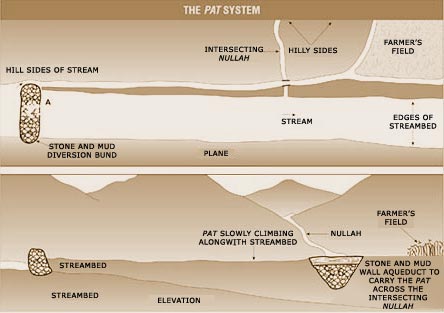
Tankas :
Tankas (small tank) are underground tanks, found traditionally in most Bikaner houses. They are built in the main house or in the courtyard. They were circular holes made in the ground, lined with fine polished lime, in which raiwater was collected. Tankas were often beautifully decorated with tiles, which helped to keep the water cool. The water was used only for drinking. If in any year there was less than normal rainfall and the tankas did not get filled, water from nearby wells and tanks would be obtained to fill the household tankas. In this way, the people of Bikaner were able to meet their water requirements. The tanka system is also to be found in the pilgrim town of Dwarka where it has been in existence for centuries. It continues to be used in residential areas, temples, dharamshalas and hotels.
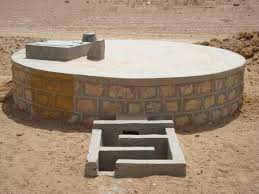
Khadin :
A khadin, also called a dhora, is an ingenious construction designed to harvest surface runoff water for agriculture. Its main feature is a very long (100-300 m) earthen embankment built across the lower hill slopes lying below gravelly uplands. Sluices and spillways allow excess water to drain off. The khadin system is based on the principle of harvesting rainwater on farmland and subsequent use of this water-saturated land for crop production.
First designed by the Paliwal Brahmins of Jaisalmer, western Rajasthan in the 15th century, this system has great similarity with the irrigation methods of the people of Ur (present Iraq) around 4500 BC and later of the Nabateans in the Middle East. A similar system is also reported to have been practised 4,000 years ago in the Negev desert, and in southwestern Colorado 500 years ago.
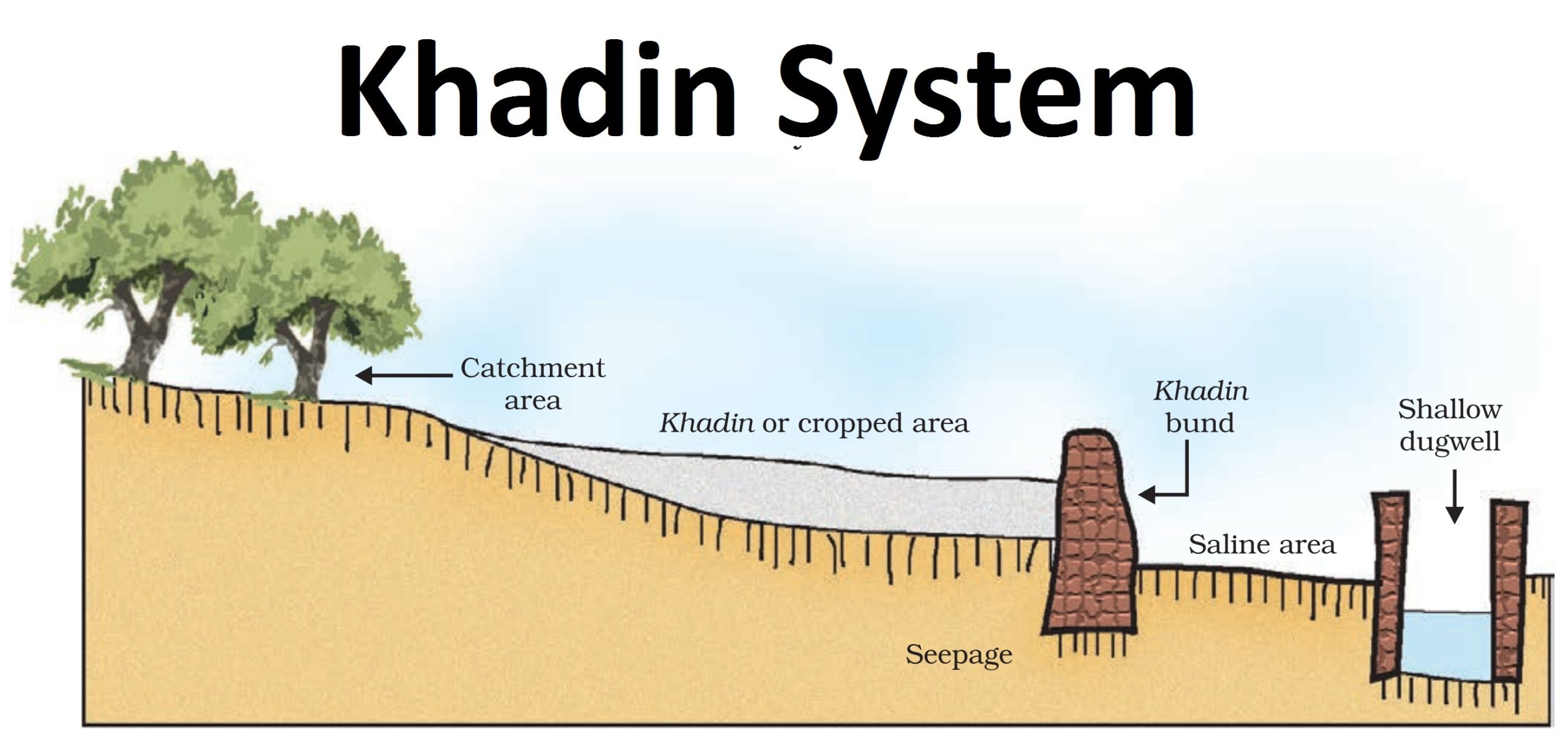
Vav / vavdi / Baoli / Bavadi :
Traditional stepwells are called vav or vavadi in Gujarat, or baolis or bavadis in Rajasthan and northern India. Built by the nobility usually for strategic and/or philanthropical reasons, they were secular structures from which everyone could draw water.
Rani-ki-Vav (the Queen’s Step well) at Patan, Gujarat is conferred as World Heritage Site by UNESCO. Stepwells are a distinctive form of subterranean water resource and storage systems in India, constructed in 3rd millennium BC. It has seven levels of stairs; having 10 mtrdia& 30 mtr depth.
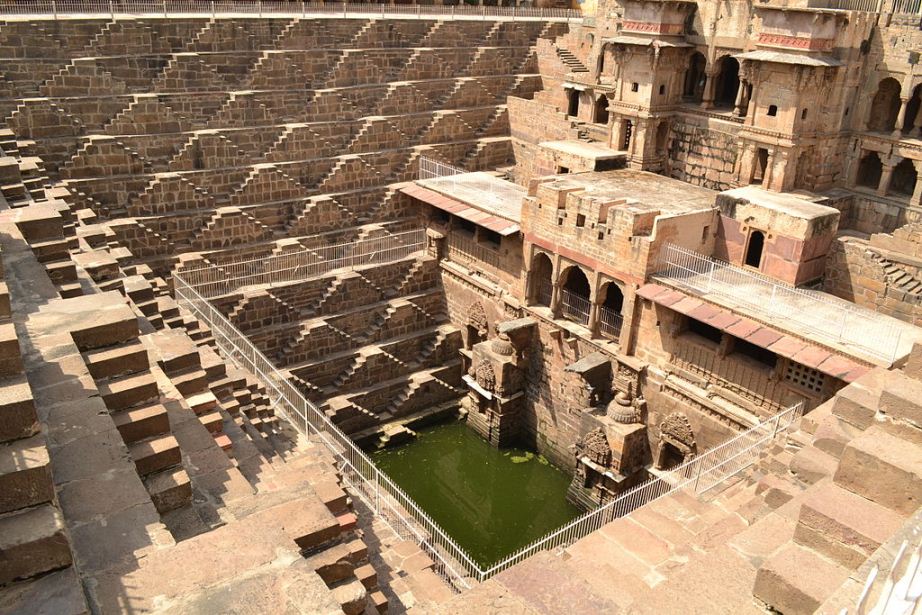
Most of them are defunct today.The construction of stepwells date from four periods: Pre-Solanki period (8th to 11th century CE); Solanki period (11th to 12th century CE); Vaghela period (mid-13th to end-14th century CE); and the Sultanate period (mid-13th to end-15th century CE).
Sculptures and inscriptions in stepwells demonstrate their importance to the traditional social and cultural lives of people.
Step well locations often suggested the way in which they would be used. When a stepwell was located within or at the edge of a village, it was mainly used for utilitarian purposes and as a cool place for social gatherings. When stepwells were located outside the village, on trade routes, they were often frequented as resting places. Many important stepwells are located on the major military and trade routes from Patan in the north to the sea coast of Saurashtra. When stepwells were used exclusively for irrigation, a sluice was constructed at the rim to receive the lifted water and lead it to a trough or pond, from where it ran through a drainage system and was channelled into the fields.A major reason for the breakdown of this traditional system is the pressure of centralisation and agricultural intensification.
When, If not now….
If we learn to respect nature, we can live with it. But we are working against nature today. Instead of large Dams, why can’t we have large, local reservoirs storing rainwater from nearby areas and feed the local communities? The ecological rationality of these ancient Indian systems must be understood and blended with the challenges of today. The biggest crisis is the Climate Change. It will bring more rain with fewer number of rainy days. This means more flooding in cities.
The only way to manage this is to increase the rainwater harvesting potential of urban regions, with lakes, ponds and parks with reservoirs and recharge structures. Building this, is quite simple. It requires to plan for a pond and a catchment which must be kept clean. It also makes us conscious of our local environment. And it requires community participation, from each one of us.
We are highly prone to both droughts and floods, so building resilienceis very important. Smart Engineering coupled with sensible service to nature will be important. For example, instead of relying only on big levees to control floods, we can strategically reconnect rivers to their natural food plains as floods get more intense, this will help reduce risks and also recharge ground water. These solutions are being tried in the US, Mississippi river basin and in Europe’s Danube river basin. Enhancing aquifer recharge and reducing withdrawals are crucial for India.
We need to work together to repair the water cycle and replenish ground water reserves. Groundwater has been depleted in some of the most important irrigation farmland across India. Groundwater is a critical reserve during droughts. We must replenish this by reducing pumping to levels that match recharge and actively recharging the aquifers we’ve depleted. Another important strategy to safeguard drinking water is to protect our water sheds because healthy forests help cleanse water and mitigate wildfires.
We must rebuild our relationship with water now. We can do this by respecting ancient India’s rainwater harvesting wisdom.
Vardhman Envirotech
India’s Passionate Rainwater Company.
